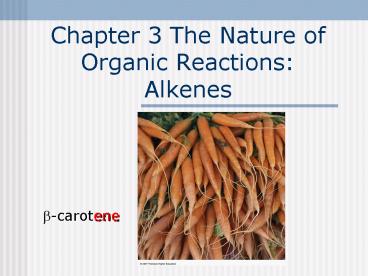Chapter 3 The Nature of Organic Reactions: Alkenes - PowerPoint PPT Presentation
1 / 34
Title:
Chapter 3 The Nature of Organic Reactions: Alkenes
Description:
Chapter 3 The Nature of Organic Reactions: Alkenes. b-carotene ... P.90. FIGURE 3.6 MECHANISM: The mechanism of the electrophilic addition of HCl to ethylene. ... – PowerPoint PPT presentation
Number of Views:217
Avg rating:3.0/5.0
Title: Chapter 3 The Nature of Organic Reactions: Alkenes
1
Chapter 3 The Nature of Organic Reactions Alkenes
b-carotene
2
Alkene - Hydrocarbon With Carbon-Carbon Double
Bond
3
3.1 Naming alkenes
- 1. Parent hydrocarbon
- the longest C chain that contains the CC bond
- Using the suffix ene
- 2. Number beginning at
- Nearer the end of CC
- Nearer the first branch point
- 3. Substituents
- Number list them alphabetically
- Diene, triene..
4
(No Transcript)
5
(No Transcript)
6
Cycloalkenesubstituents
7
(No Transcript)
8
PROBLEM 3.1
PROBLEM 3.2
P.76
9
3.2 Electronic Structure
- Sp2, Angle120, no rotation
- Rotation of ? Bond Is Prohibitive (unlike a C-C
single bond).
10
3.3 Cis-Trans Isomers of Alkenes
11
3.3 Cis-Trans Isomers of Alkenes
Stability steric (spatial) strain
12
3.3 Cis-Trans Isomers of Alkenes
13
3.4 E,Z Designation
Sequence rules
14
1. Higher atomic number gets higher priority
15
2. Look at the 2nd atoms -CH3lt-C2H5 -C-C lt
-C-Cl -O-Hlt-O-CH3
16
3. Multiple bonds atoms the same number of
single bonded atoms
17
Practice problem
18
3.5 Kinds of Organic Reactions
- Addition reactions two molecules combine
- AB ? C
19
Elimination reactions
Substitution reactions
P.83
20
Rearrangement reactions
P.84
21
3.6 How Reactions Occur Mechanisms
Mechanism a detailed account of the motions of
the valence electrons Mechanism is a model for a
chemical reaction represents our best guess as to
what is occurring.
P.84
22
Heterogenic Homogenic Polar Radical Reactions
FIGURE 3.4 Some one-step reaction mechanisms.
The motion and number of electrons are depicted
with single-and double-headed arrows that start
with the electron(s) and end at an atom or bond.
P.85
23
3.7 Mechanisms of polar Rxns
- Polar reactions Polar reactions are more common
- Electron-rich
- Electron poor
24
- Nucleophiles
- electron-rich reagent
- Electron donor
- Electrophiles
- Electron poor reagent
- Electron acceptor
25
(No Transcript)
26
(No Transcript)
27
3.8 The Mechanism of an Organic Reaction
- Example of polar reaction
- Electron density CC gt C-C
28
P.89
29
FIGURE 3.6 MECHANISM The mechanism of the
electrophilic addition of HCl to ethylene. The
reaction takes place in two steps and involves an
intermediate carbocation.
P.90
30
3.9 Describing a Reaction
- Energy diagrams
- transition state
- Intermediate If a reaction occurs in more than
one step, it must involve species that are
neither the reactant nor the final product
31
3.9 Describing a Reaction Reaction Energy
Diagrams and Transition States
P.91
32
3.10 Describing a Reaction Energetics and
Catalysis
P.93
33
PRACTICE PROBLEM 3.7
P.94
34
(No Transcript)































